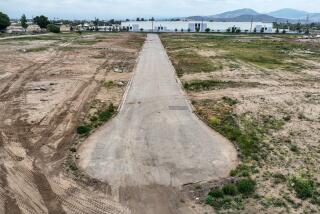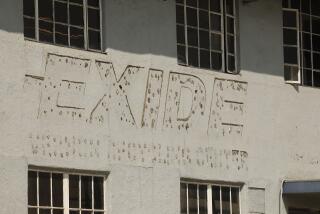The Belmont Learning Experience
- Share via
In their haste to open a badly needed new high school near downtown, Los Angeles school officials allowed construction of the Belmont Learning Complex to begin without completing a thorough environmental assessment of the site, which lies partly over a former oil field.
During the construction, which began in 1997, soil testing turned up explosive levels of methane under a classroom building and in other areas that had been thought to be free of contamination.
With the $200-million project more than half done, tests are now underway to determine the extent of the contamination and what must be done to ensure the safety of those who will use the campus.
Depending on the findings, which could be released this month, the scheduled July 2000 opening of the 4,800-student campus could be delayed and the price tag could rise by millions of dollars.
Preliminary results suggest no hazards so serious that the project would need to be abandoned, said Angelo Bellomo, an environmental consultant heading the study for the Los Angeles Unified School District.
Bellomo said he expects to recommend more rigorous safeguards, such as the installation of a vacuum pressurized venting system, to draw methane and other contaminants safely from the soil beneath school buildings.
Measures may also have to be taken to eliminate oil byproducts floating on shallow ground water as well as any methane-producing oil deposits left by drilling crews during oil field operations during the first two decades of the century.
Bellomo has estimated that the remedial measures could cost up to $10 million.
Construction is continuing during the testing program, but the developer, Temple-Beaudry Partners, has agreed to work only on buildings that were already partly erected when deficiencies in the environmental assessment were disclosed last fall.
The testing program has interrupted the construction schedule of the multipurpose building, the administration building and one classroom building.
Identified Areas of Concern
Limited sampling in spring, 1998, has shown methane hot spots and contaminated ground water.
Testing locations
Soil probes
Vapor probes
Ground water monitoring wells
Oil wells
Active
Non-active
How Methane is Formed
Testing is being done for two types of methane:
* shallow biogenic methane-bacteria in the soil decomposes oil discarded during drilling, leaving methane as a byproduct.
* petrogenic methane is formed along with other gases deep within the oil field, and rises to the surface through rock layers or old oil well shafts.
Geology of the L.A. Oil Field Area
The soil beneath Belmont is made up mostly of sedimentary layers that were laid down millions of years ago before the inland seas that once covered the L.A. Basin receded. Over time, a combination of pressure and tectonic activity and erosion brought oil-bearing layers close to the surface. In the rigid rock formation, older wells were either lined with wood or not lined at all.
* At the height of production, there were 1,500 oil wells in the L.A. Oil Field. There are about 50 remaining, mostly in the central and eastern sections. They still produce small amounts of oil, fewer than 10 barrels a day.
* There are four wells still in production on the Belmont school site (near a playing field). They are used to relieve methane pressure built up underground.
* Elevation of the oil field averages 600 feet below surface.
Underground Testing
Environmental analysis is identifying areas of concern, especially at the northwest edge of the multipurpose room and community center.
Soil vapor probes are placed in holes at 10-, 25- and 40-foot depths. The holes are capped and gases below are allowed to accumulate at least 48 hours. The holes are then opened and accumulated gas is drawn out and measured.
Soil boring determines the subsurface geology and provides soil samples for analysis.
Ground water monitoring wells are placed into shallow groundwater which occurs across the site at depths between 15 and 80 feet. Holes are drilled and plastic pipe is inserted. Water drawn up through the pipe is submitted to a lab and analyzed for volatile organic chemicals such as solvents and benzene.
Methane presents a risk of explosion when it accumulates in an enclosed structure. Mixtures of methane and air, with the methane content between 5% and 15% by volume, are explosive.
Protecting the Site
Methane in the soil will never be eliminated, but can be safely vented out. A venting system has been proposed at Belmont:
1. Perforated Pipe
Collects methane rising in the soil and carries to vent pipe outside building. A pump may be added to suck methane into the pipe.
2. Sand
Forms layer above pipe.
3. Membrane
Rubber-band-like film is sprayed on to form an impermeable layer.
4. Sand
Methane sensors installed to detect breach of membrane.
5. Concrete
Slab forms the first floor of building.
Belmont Timeline
Sept. 18, 1990
L.A. Unified condemns Ambassador Hotel to use as site for downtown high school; owner Donald Trump threatens court action over price.
Sept. 20, 1993
With real estate values falling, Board of Education decides to drop Ambassador site and buy 24 acres at 1st Street and Beaudry Avenue from a Japanese subsidiary of Shimizu Corp.
Aug. 21, 1995
District development Director Dominic Shambra unveils innovative plan for 5,300-student school, together with low-cost housing and retail center.
Nov. 18, 1996
Despite warnings about inadequate assessment of oil field hazards, Board of Education approves environmental impact report for Belmont Learning Complex.
Summer 1997
Construction begins.
April 1998
Testing by contractor detects methane seepage under a classroom building.
Sept. 28, 1998
State Sen. Tom Hayden (D-Los Angeles) calls hearing to criticize failures in L.A. Unified’s environmental reviews.
Nov. 5, 1998
Supt. Ruben Zacarias announces appointment of a team of experts to obtain state environmental certification for Belmont and other school sites.
Nov. 17, 1998
Department of Toxic Substances Control informs district that Belmont property requires further environmental assessement.
Feb. 9, 1999
State approves district’s work plan for $700,000 of new tests.
More to Read
Sign up for Essential California
The most important California stories and recommendations in your inbox every morning.
You may occasionally receive promotional content from the Los Angeles Times.










